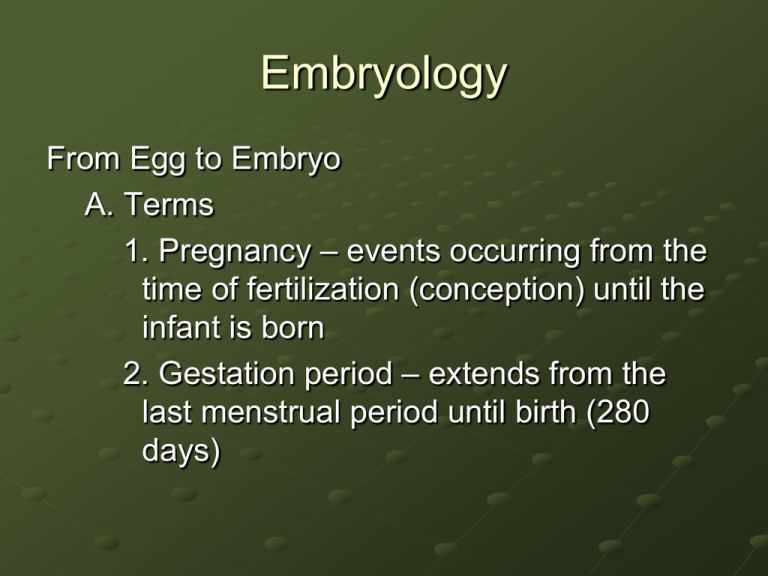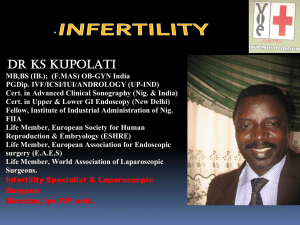
Embryology
From Egg to Embryo
A. Terms
1. Pregnancy – events occurring from the
time of fertilization (conception) until the
infant is born
2. Gestation period – extends from the
last menstrual period until birth (280
days)
Embryology
3. Conceptus – refers to the developing
offspring at any time during the pregnancy
A) Pre-embryo – first two weeks following
fertilization
B) Embryo – from the third through the
eighth weeks after fertilization
C) Fetus – ninth week through birth
D) Infant – at birth
Embryology
B. Fertilization – fusion of sperm and egg
1. Copulation must occur accordingly
A) Egg is viable for 12-24 hrs after
ovulation
B) Sperm is viable for 24-72 hrs after
ejaculation
C) Copulation must occur no more than
three days before ovulation and no later
than 24 hours after
Embryology
2. Sperm must reach the egg
A) Only a few hundred thousand sperm in a
males ejaculate actually make it to the uterine
tubes
1) Millions leak immediately from the vagina
2) Millions are destroyed by acidity of the
vagina
3) Only about 2,000-3,000 sperm actually
make it to the egg
Embryology
3. Sperm must penetrate the egg
A) requires capacitation, an acrosomal
reaction, and fertilization membrane
formation
1) Capacitation – as the sperm swims
towards the oocyte, the cholesterol that
keeps the acrosome “tough” degrades
causing the membrane to weaken and
the enzymes within to be released
a) Takes about 6-8 hours
Embryology
2) Acrosomal reaction – release of the
acrosomal enzymes triggered by the sperm
coming into contact with oocyte membranes
a) First-arriving sperm create holes in the
corona radiata
i) it often takes hundreds of sperm to
create the holes
b) A later-arriving sperm reaches the zona
pellucida and releases enzymes creating a
hole in the zona pellucida
Embryology
c) Once the sperm reaches the oocyte
membrane, its nucleus is pulled into the
oocyte cytoplasm
3) Upon entry of the nucleus, the oocyte
creates a fertilization membrane just beneath
the zona pellucida
a) forces out other entering sperm &
prevents entry of future sperm
Embryology
4. Meiosis II must be completed
A) After a sperm’s nucleus enters the oocyte,
the secondary oocyte completes meiosis II
and ejects the second polar body
B) The ovum and the sperm nuclei swell to form
the male and female pronuclei which merge
giving rise to the zygote
1) zygote – fertilized egg
Embryology
C) Twins
1) in most pregnancies, only a single egg is
fertilized resulting in a single, implanted
embryo; there are, however, times when
multiple embryos are produced and implant
themselves in the uterus resulting in
multiple fetuses
Embryology
a) fraternal (non-identical) twins – result when
the female produces more than one oocyte
during her monthly cycle (and more than one
is fertilized)
i) children may be of the same sex or
different sexes and are not genetically
identical
Embryology
b) identical twins – result when a single zygote
splits into multiple embryos following
fertilization
i) children will be of the same sex and
genetically identical
Embryology
C. Pre-embryonic Development
1. Cleavage occurs as the zygote travels
through the uterine tube and into the uterus
A) Period of rapid mitotic divisions
1) 2-cell stage – 36 hours after fertilization
2) 4-cell stage – about 48 hours
3) 8-cell stage – about 72 hours
4) Morula – solid ball of cells that is 16 or
more cells big
Embryology
2. The morula hollows out and fills with fluid (now
known as a blastocyst)
A) Blastocoel – hollowed-out region of the
blastocyst
3. The zona pellucida disintegrates and releases
the blastocyst
A) The blastocyst is composed of 2 cell layers
1) Trophoblasts –the large flattened cells of
the outer layer
a) will take part in placenta formation
Embryology
b) secrete hCG to prompt the corpus luteum
to continue secreting progesterone in order
to maintain the endometrium
2) Inner Cell Mass (ICM; a.k.a embryoblast) – a
cluster of small rounded cells of the inner
layer
a) becomes the actual embryo
Embryology
4. Implantation
A) When the blastocyst reaches the uterus, it
initially floats freely, receiving nourishment
from the endometrial secretions (uterine milk)
B) Six or seven days after ovulation, the
trophoblast cells embed into the endometrium
and begin secreting digestive enzymes that
degrade the endometrial surface
Embryology
C) As the endometrium is eroded, the
blastocyst burrows into the lining
D) The endometrial lining reacts by growing
over the blastocyst
E) The chorion develops from the trophoblast
cells starting to give rise to the placenta
5. Placenta Formation
A) Functions to exchange waste products and
blood gases
Embryology
B) The chorion develops chorionic villi which
extend into the endometrium where they
come into contact with maternal blood supply
C) Placenta takes over the role of secreting
hCG and also secretes relaxin
1) causes the pubic symphysis to soften and
become more flexible
Embryology
Embryonic Development
A. The blastocyst is converted into the gastrula
in which the embryonic membranes develop
and three primary germ layers form
1. Gastrulation – process by which the
embryonic tissues are formed
2. The embryonic membranes form as the
inner cell mass splits to form upper and
lower cell layers
Embryology
A) Amnion (amniotic sac) – forms from the upper
cell layer
1) This sac fills with amniotic fluid that provides
a buoyant environment that protects the
developing embryo
B) Yolk sac – forms from the lower cell layer
1) It serves to form part of the digestive tube,
produces the earliest blood cells and blood
vessels, and is the source of primordial germ
cells of the embryo’s gonads
Embryology
C) Allantois – forms as a small out-pocketing of
the yolk sac
1) Acts as the structural base of the umbilical
cord and becomes part of the urinary
bladder
D) Chorion – develops from proliferating
trophoblast cells giving rise to the placenta
Embryology
3. During the third week, the primary germ layers
form along the embryo
A) Ectoderm – gives rise to skin and nervous
system
B) Endoderm – gives rise to the functional
linings of the digestive, respiratory, and
urogenital systems
C) Mesoderm – gives rise to muscle, bone,
blood vessels, kidneys and all the other
components of organs (except linings)
Embryology
4. Circulation in fetus versus newborn
A) Fetal circulation has several adaptations so
that the lungs and liver are largely bypassed
because they are non-functional
1) The umbilical vein carries oxygen- and
nutrient-rich blood from the placenta to the
fetus
2) The umbilical arteries carry deoxygenated,
waste-laden blood from the fetus to the
placenta
Embryology
3) The ductus arteriosus and foramen ovale
allow blood to partially bypass the lungs
4) The ductus venosus allows blood to
partially bypass the liver
Embryology
5. Development through the end of the embryonic
period
A) Head nearly as large as body
B) All major brain regions present; first brain
waves in brain stem
C) Liver disproportionately large and begins to
form blood cells
D) Limbs present; digits initially webbed but
become separated later
Embryology
E) Ossification begins and spontaneous muscle
contractions occur
F) Cardiovascular system is fully functional
G) All body organs/systems present though not
fully developed
H) Final approximate crown-to-rump length is
30 mm (1.2 inches)
Events of Fetal Development
*refer to notes*
Embryology
Parturition (Birth)
A. Initiation of labor
1. High estrogen levels induce oxytocin
receptors to increase on the myometrial
cells and inhibit progesterone secretion by
the placenta
A) Weak irregular contractions begin
2. Fetal cells produce oxytocin, which
stimulates prostaglandin production by the
placenta
Embryology
A) Both hormones stimulate contraction
3. Increasing stress causes the hypothalamus
of the mother to cause oxytocin release by
the pituitary gland (posterior)
Embryology
B. Stages of labor
1. Dilation stage – rhythmic contractions occur
until the cervix dilates 10 cm
A) The head of the fetus rotates and
descends through the pelvic outlet
2. Expulsion stage – extends from full cervical
dilation (10cm) until birth of the infant
3. Placental stage – delivery of the afterbirth
A) Consists of the placenta and its attached
membranes
Embryology
C. Lactation
1. The breasts are prepared for lactation
during pregnancy by high blood levels of
estrogen, progesterone, and placental
lactogen
A) Oxytocin is important in stimulating the
“let-down” phase
1) let-down = the actual release of milk
from the alveoli of the mammary glands
Embryology
2) suckling also stimulates the release of
oxytocin and promotes let-down
a) the let-down will occur in BOTH
breasts, not just the suckled one
2. Colostrum is produced towards the end of the
pregnancy and for the first 2-3 days after birth
A) A pre-milk fluid that is a fat-poor fluid that
contains more protein, vitamin A, and
minerals than true milk
Embryology
3. True milk is produced around day 3 in
response to suckling which stimulates the
hypothalamus to prompt the pituitary gland to
secrete even more prolactin and oxytocin
4. At first, ovulation and menses are absent or
irregular during nursing







